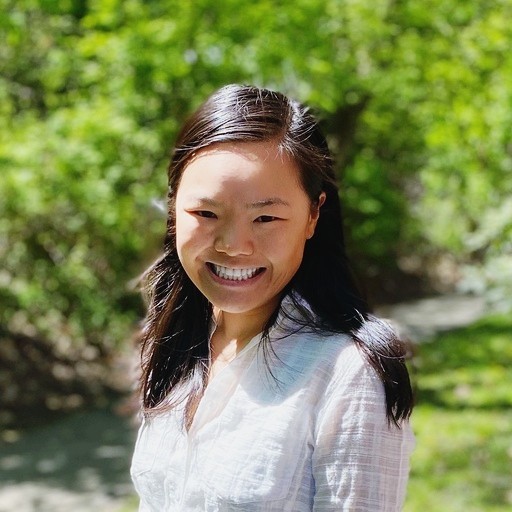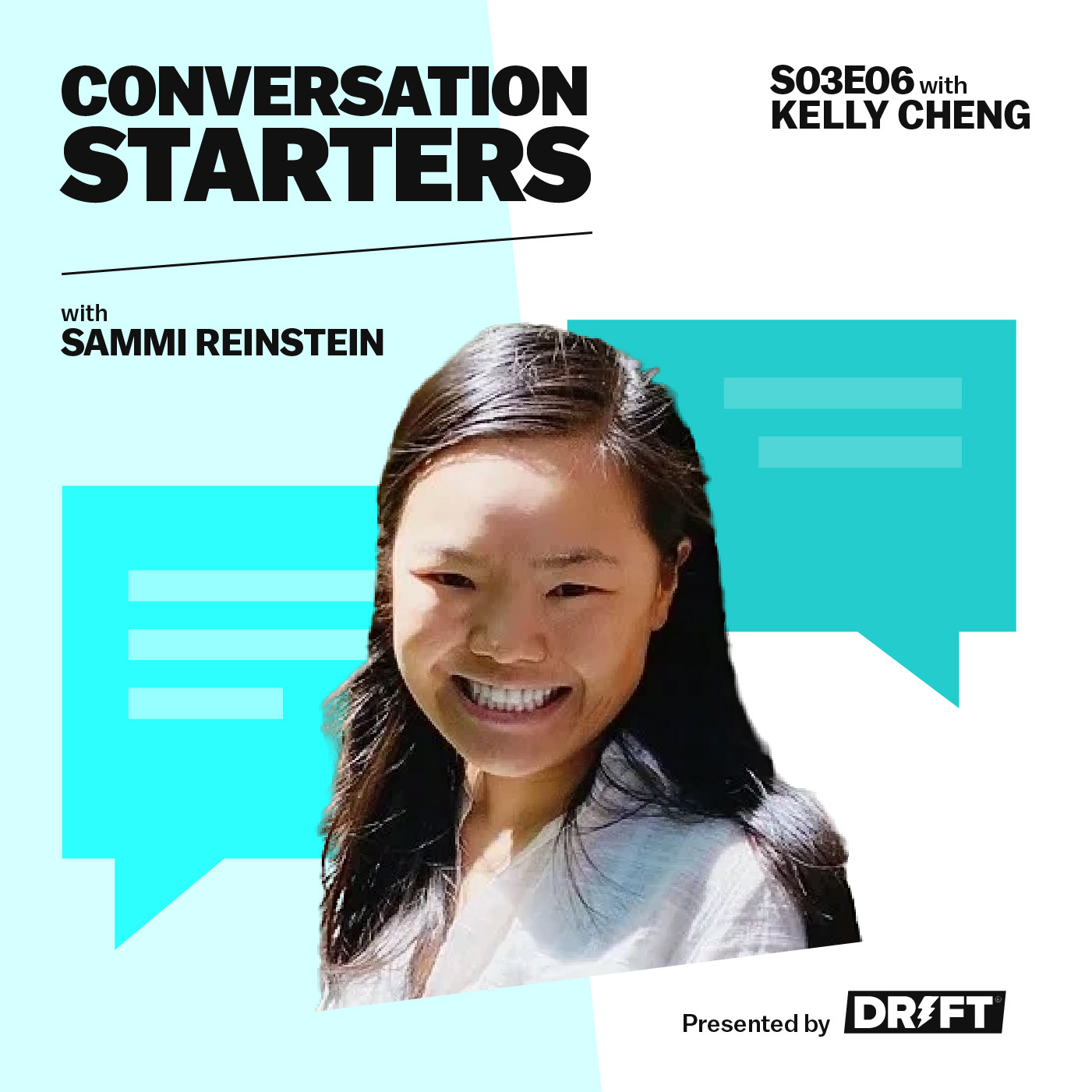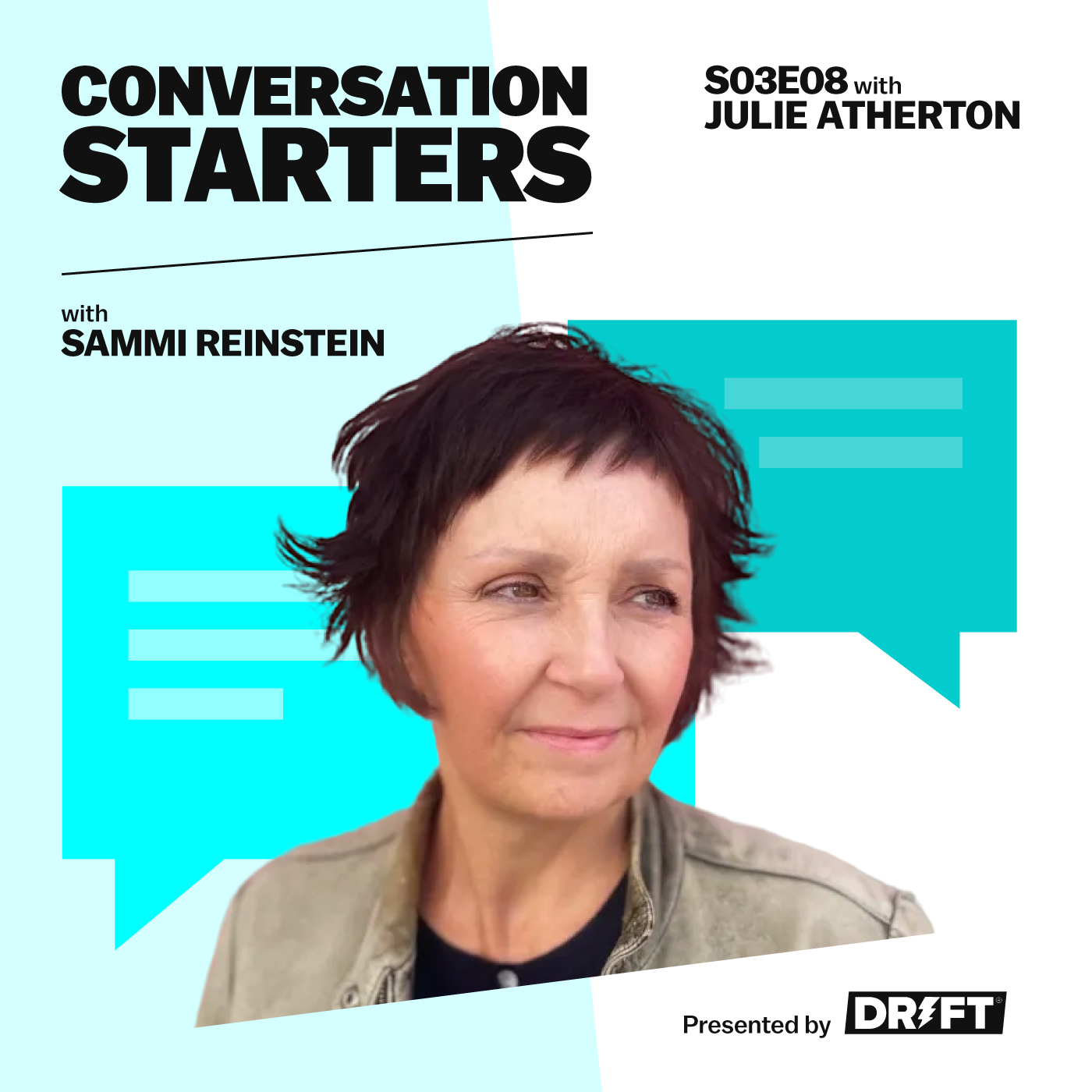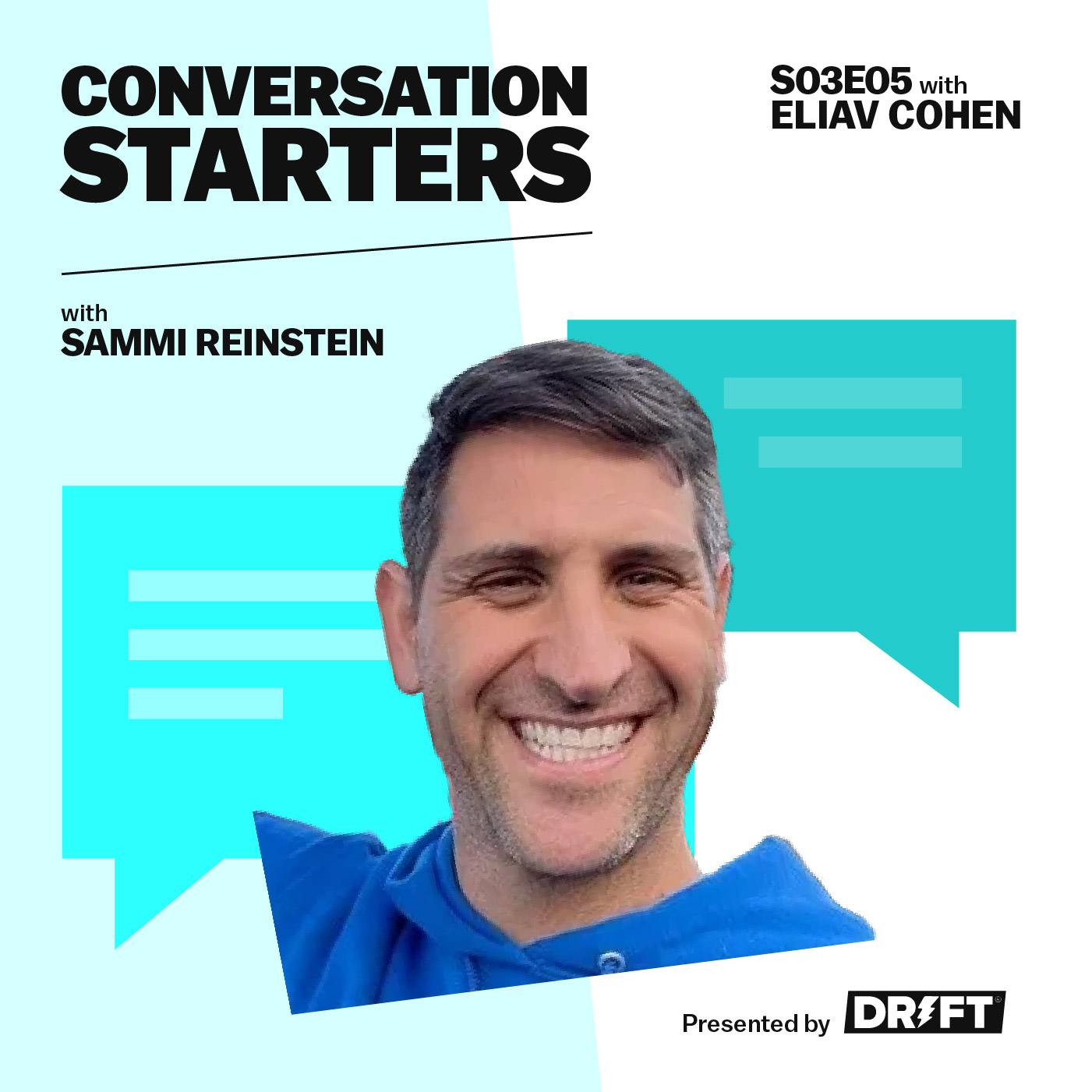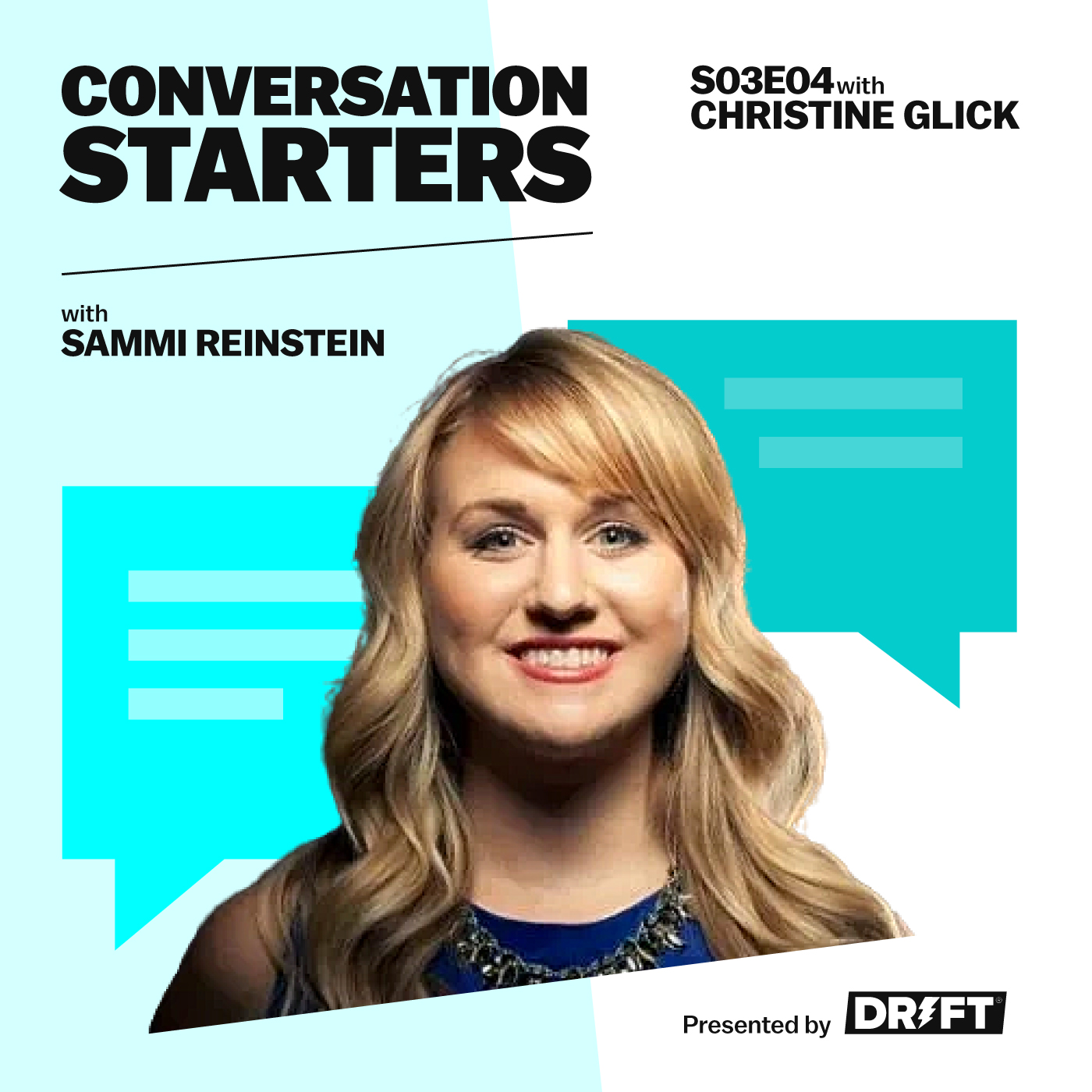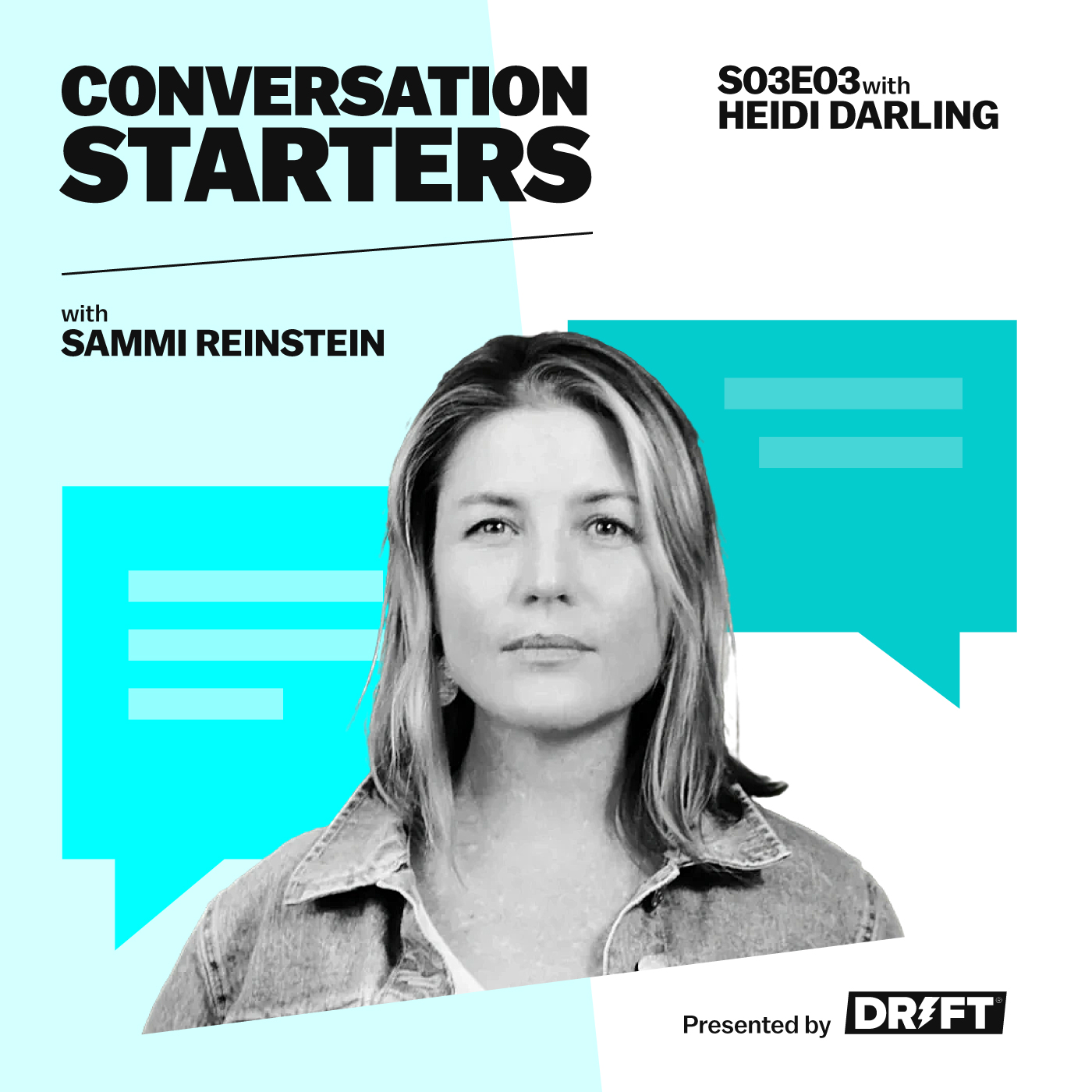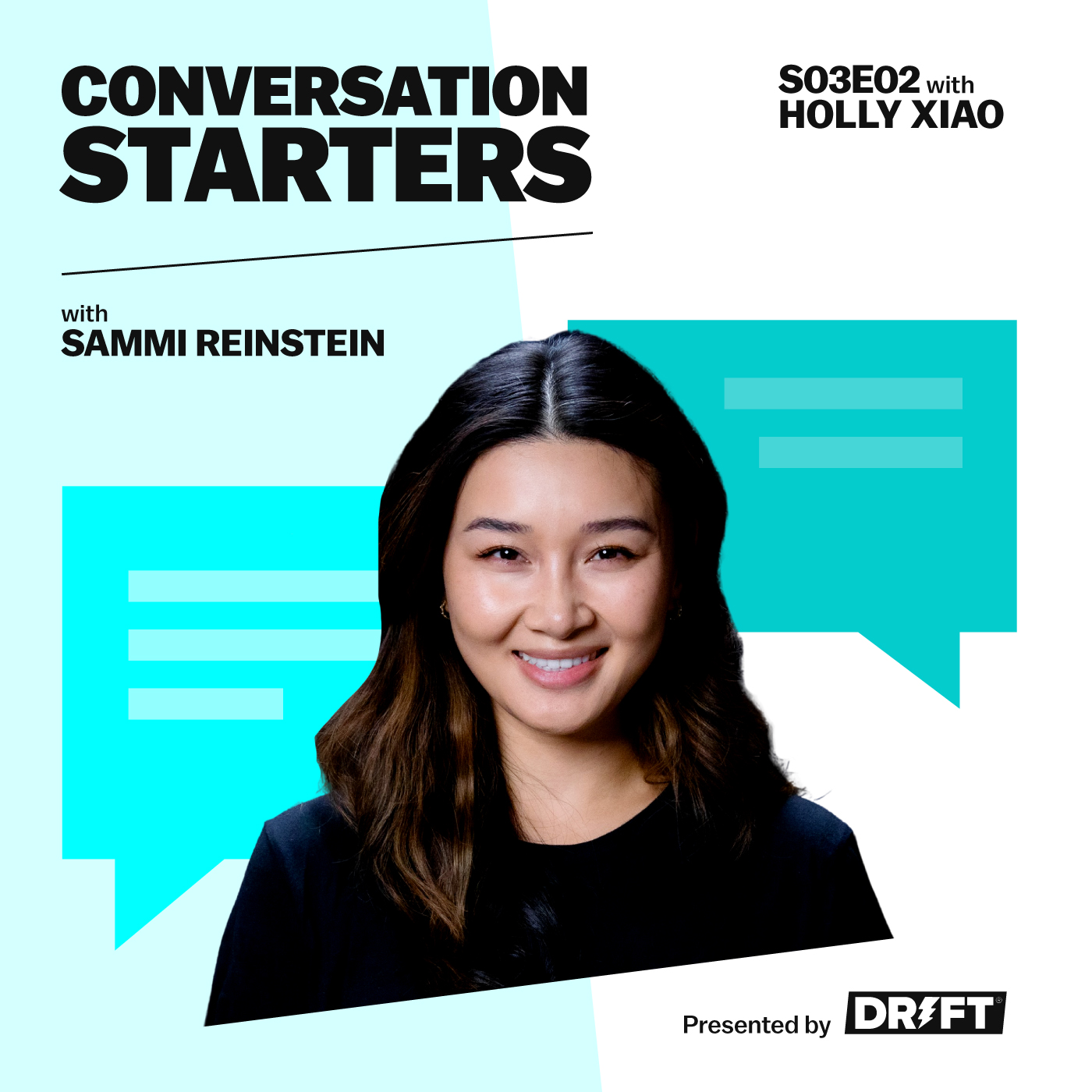3.6: How Events Can Help You Continue the Conversation (Kelly Cheng)
- 0.5
- 1
- 1.25
- 1.5
- 1.75
- 2
Sammi Reinstein: Hey, this is Sammi Reinstein and you're listening to Conversation Starters. On this show, we talk all about bringing conversations back to B2B marketing and selling. Because if there's one thing we know about doing business in the revenue era, it's that the best customer experience wins.
Elizabeth: Season three of Conversation Starters is brought to you by Really Good Salesplays, a landing page built to inspire your sales team, whether they're inbounding, outbounding, or managing a deal. These plays are proven to generate pipeline and close deals, so you can celebrate more wins. Check them out at drift. ly/ salesplays. Now, to the episode. Sammi, remember back to the beginning of the season when I had you do a live podcast recording?
Sammi Reinstein: Yeah, I remember that. How could I forget?
Elizabeth: How could you forget that one?
Sammi Reinstein: I literally, I came back from a month off, for sabbatical, and Elizabeth was like, " Welcome back. So, for our first episode, it's going to be live."
Elizabeth: Surprise.
Sammi Reinstein: Surprise.
Elizabeth: But it went great. And it was on Goldcast. And we, at Drift, use Goldcast for all of our virtual events. So, webinars live podcasts, and other of our bigger conferences, like RevGrowth. And I've just been so interested in Goldcast and the whole product, that I thought, " Why don't we talk to an events person, someone in Goldcast on how they think about the ROI of events, continuing conversations, and using events at every stage of the funnel.
Sammi Reinstein: So today I'm really excited to talk to Kelly Cheng, who is the head of marketing and growth at Goldcast. And like we mentioned, Goldcast is a revenue driven event marketing platform. She's going to talk to us all about how marketers and sellers can and should think about branded events. Like Elizabeth said, at every stage of the customer journey, at every stage of the funnel. So let's get into it.
Elizabeth: But first one more thing.
Sammi Reinstein: Oh.
Elizabeth: I have a conversation starter for you, Sammi.
Sammi Reinstein: Ooh. Okay, what is it this time?
Elizabeth: What is your go- to karaoke song? I know you have one. You probably have three.
Sammi Reinstein: I have to say that Breaking Free-
Elizabeth: Oh, High School Musical?
Sammi Reinstein: ... from High School Musical,really gets the crowd going, because you can get a friend up there. You're not as nervous.
Elizabeth: Yeah, sing along.
Sammi Reinstein: Everyone knows it. Is it really hard to sing? Yes. Do you not realize how hard it is to sing until you're up there in front of everyone? Also, yes. But I will be sure to ask Kelly as well what her favorite karaoke song is.
Elizabeth: And to just see her answer.
Sammi Reinstein: So, before we dive in Kelly, we are starting season three by asking some conversation starters ourselves.
Kelly Cheng: Yeah?
Sammi Reinstein: Just to break the ice, start the conversation, if you will. So, not to put you on the spot, but our conversation starter for you is what is your go- to karaoke song?
Kelly Cheng: Oh, my go- to karaoke song. I'm a huge Taylor Swift fan, but I've got to say Build Me Up, Buttercup is the best karaoke song for me.
Sammi Reinstein: That's a great one.
Kelly Cheng: Yeah.
Sammi Reinstein: Gets the crowd going.
Kelly Cheng: Yeah, it's a crowd-pleaser.
Sammi Reinstein: It's not too long. Sometimes, when you do karaoke and you're up there and you're like, " Whoa, this song is really long. I did not commit to standing up here.
Kelly Cheng: Or, something's way too fast. I don't remember it being so fast.
Sammi Reinstein: You're like, " Wait, wait, I actually don't know the words. I only know the chorus, I only know the bridge." Awesome. Well, now that we know a little bit more about you and your go- to karaoke song, would you mind just giving yourself a quick intro, who you are and what you do at Goldcast.
Kelly Cheng: Sure. So I'm Kelly Cheng. I am the head of growth at Goldcast, which is a revenue- driven event marketing platform. I've been at Goldcast since October, 2021, so coming up on my one year. I lead the marketing team, and our goals are really to drive lead generation, brand awareness and adoption of our product. I've been in marketing for over last 10 years. I graduated learning about marketing, knowing exactly that I wanted to be in marketing, and so, super happy to be here today.
Sammi Reinstein: Awesome. Well, congrats on one year at Goldcast. And I see you also just raised a Series A, which is very exciting, I'm sure. So, we talk a lot on the podcast. I mean the conversation starters is our name, and we do our conversation starters, and we talk a lot about starting conversations, but also starting the right conversations. And I think with events, and specifically what Goldcast does, you're inviting in new people and new personas and maybe new industries. And there's a lot of different ways that you can start the right conversation through events. But I wanted to start by doubling down into something you said on a webinar, with Alice. And you said it's important to talk with sales and customer success to identify best fit prospects for event registration. So can you talk a bit about what does that alignment look like in practice?
Kelly Cheng: For sure. So, when you're looking at an event, events are a great place for people to network and connect. But outside of that, it's also a great place for brands to be able to share content, thought leaders to be able to share their perspectives on certain topics. And so, when you're having an event, it's really a distribution channel for content. And so, lining your target audience, your personas, with the content that you have in mind is super important. If your end metric is pipeline, you have a bunch of leading KPIs that you're going to be able to be tracking before you get to that pipeline number. Some of them may include leads getting created, registrations, people actually attending. None of that, those metrics, are going to skyrocket unless you have that alignment. If your content speaks to the end consumer of that content, then you're going to see that organic engagement, and that's where you see magic happen with events.
Sammi Reinstein: Yeah. Yeah. I mean that is extremely important, the alignment. And also, if you have that alignment, pre- event, it means post- event, hopefully, your teams are doing a really good job following up, because they're bought in. They know that their target accounts or whoever that best fit prospect may be, is going to that event and is specific to them and their needs.
Kelly Cheng: Exactly. And so, we see marketing as the person responsible, or the team responsible, for creating this content. But in order for the event to be successful, we need to fill butts on seats. And that's where we lean on our sales and our CS teams. How can you help get the word out, get the right people signing up, so that we can have the successful event, from pre- event, during event, all the way through to post- event?
Sammi Reinstein: What do you find to be most successful, the channels that sales and CS can use to help spread that word? Is it enabling them through social or just through their calls that they're having with their prospects and customers?
Kelly Cheng: There's definitely certain channels that are more impactful than others. We, at Goldcast, see organic social, it's just organic referral traffic being the thing that drives the most results for us. But it's also just identifying the right opportunities. If a CSM is having a QBR call and it's going really well, it might be a good opportunity to invite them to an event or ask for a G2 review. So just really being in tune with how the response is and finding opportunities within that conversation to plug your CTAs. It is an art and you do have to go through experiences to understand how to identify those opportunities. But when you are able to identify those opportunities and scale it that way, you're not only going to get a successful event registration numbers, but you're also going to get this amazing bond between your brand and your customers.
Sammi Reinstein: Yeah, and speaking of... So, we're starting the right conversations, right? We have that alignment with customer success and sales, and we have that best- fit prospect, and we are encouraging and enabling sales and CS to get people to the event. And then post- event, we're thinking now about how can we continue the conversations? So, how can marketers best enable their sales teams and customer teams, for that matter, to follow up with event attendees and start those or continue those conversations?
Kelly Cheng: This is a great question. And so, we, at Goldcast, we treat attendees and people that did not attend separately. We do not treat them all the same. I think it's super important to treat everybody as individuals as much as possible at scale. And so, for attendees at Goldcast, on all the events that we run, obviously, run all of our events on our own platform, we always include some way to learn more about our audience. So whether it's executing a poll, asking what's your favorite color or maybe even something super random, maybe something related to the content. But the point is, that all that data gets synced through from our platform to marketing automation platforms, through to Salesforce. So then the salesperson will be able to understand, oh, this person's actually interested in blue versus yellow. So in my follow up, I will continue that conversation by talking about blue. So, that's how we've been able to use our own platform to continue conversations from interactions that happened during the event. If you did not attend an event, what we do on the marketing side is that we write out these amazing recaps of every single session, every single event, as a tool to enable our teams to be able to speak to what happened in the event that the registrant missed. So, " Sorry you missed this. This is what happened. If you want to check it out, we have it on- demand. Here it is." So not really using that status of did not attend to sell, " Let's get a demo, let's get a meeting," but more of a nurture, " This is what you missed. Join us for the next one."
Sammi Reinstein: Yeah. And that's a really important point. If they didn't attend, it doesn't mean, necessarily, their next step is going to be, get a demo. So it's finding those ways to nurture. And I love what you said about using the poll information in the follow- up. So finding something in terms of a personalized conversation. But like you said, it's personalization at scale. You can't necessarily personalize the information to every single person, but if you're asking that poll information or thinking even about you could use the poll for what types of content would you like to see in the follow- up and bucketing that out. That is very interesting.
Kelly Cheng: Yeah. We also actually see people at, we have people asking questions in an event. We have a Q& A tab where all of our questions end up. We track that as well, so if someone has a specific question, you can continue that conversation and bring it over email and just extend that relationship from the event through to post- event.
Sammi Reinstein: Yeah. And how do you find that the post- event communication changes, depending on if it's more for your top- of- funnel audience who is just getting some awareness versus maybe a customer or a bottom- of- funnel type of customer webinar or customer event?
Kelly Cheng: Yeah, that's a great question. I mean, I think at the end of the day, the one thing that we look at, to understand how we approach these differently, is data, understanding how their engagement data has been collected up until this point for follow- up. If they're a customer, what do we want them to do next as a customer? If they're a prospect, if they're super early, if they've only been to our website twice, they're probably not ready to buy, but if they're clicking on our paid ads, they're probably Googling us and likely ready to buy. So using that data to really help inform what the next steps are.
Sammi Reinstein: Yeah. Yeah, it's that intent, and then the intent follow- up and making that personalized. When it comes to the event itself, I think that something that's on every event marketer's mind is how do I get someone there? And we talked a little bit about enabling CS and sales and having them post to social channels and employee engagement. But what do you suggest from a content perspective leading up to the event, to not only get people to register, but actually show up to the event?
Kelly Cheng: Yeah, I think a lot of times, and I've been interviewing a lot of even to marketers that have talked about how the wrong way to run an event is to... The reason to have an event is, " Oh, we have to have an event," and then building your content map afterwards. You really have to start with the content and knowing what your event is for, having that purpose before you say you're going to run it. So we always start with content, making sure that we actually have something important to say. If we're going to be asking for people's time live, then there's got to be value to it. They've got to get something out of it. We don't want to ever host an event that we don't want to attend ourselves. So always starting with the content first. And so, from the get go, we have an arsenal of promotional ways to promote the event, because we know that event marketers are going to want to attend and get out of it. What we like to do at Goldcast is tease things out. So starting with a headliner and then coming up with supporting sessions, maybe a workshop afterwards, something more and more and more so people aren't forgetting what's going to happen and you're just adding more to their plate. And then finally, something that we've seen super, super helpful is incentivizing attendance, getting people to show up by saying, " We're going to get you a coffee if you join us live for this afternoon event." People love games, so teasing out a giveaway or gamifying events. People are super incentivized that way. Another way that I've newly tried to do is, I've been trying out a lot of different social media automation tools. So sending out mass InMails to my network or lists in LinkedIn, inviting people to events. At Goldcast, we have really, really, really amazing email marketing capabilities within the platform. And something that I've seen work really well at getting people to show up is sending emails during the event, when your event's going on. Just because it's going on, doesn't meet people who can't still join or register. So sending emails during the event has actually gotten people coming in because it's top of mind, it's happening right now. If it's happening two weeks from now, it's already forgotten.
Sammi Reinstein: Yeah. I mean, I know that works for me. There's certainly been times when I've been like, I really want to join this webinar and then work gets in the way or whatever happens. Then you get that email and you're like, " Wait, oh my gosh, I do want to join." I think that's during the event, sending out that messaging and continuing the social media strategy and continuing that email strategy is really important. And I also love what you said about making sure that the event is value driven and that the attendees are going to get something out of it, and that it's built into your content roadmap. Because I'm sure there is so much great content that's coming during the event that you can repurpose after the event. So, if you're keeping it value driven, you're able to continue to repurpose, and the lifetime and life cycle of that event gets extended.
Kelly Cheng: Right. Exactly. And so, at Goldcast, we're events first, we're an event technology company. And so, the content usually starts with events and then we're able to reformat it into videos, blog posts, social posts. And so, it lives on with a much, much longer shelf life. It lives on with an on- demand version for, maybe, another six months.
Sammi Reinstein: And you have mentioned some reporting capabilities and data, and using the data to inform your decisions. I'm curious, I'd love to dive deeper into that. What do you think are some, maybe missed opportunities you see happening for event marketers when it comes to attributing influence and events as influence on the funnel?
Kelly Cheng: Something that I think that is a huge miss is when people register, but don't attend, and people remove the event as part of anything that drives pipeline. But that is another touchpoint. And maybe it's not as a high intent touchpoint as someone that's attended, but someone still made an effort to register and they didn't do that by mistake. And so, I think a lot of the times, people just assume that if they did not attend, they're not worth looking at. Maybe the new t- shirt leads of events. But I still think that they clearly saw some kind of value to it. Maybe they were busy, maybe life happened, but I don't think it's worth to write off. And so, I think that's one piece where I think you could probably milk more out of is your did not attend people.
Sammi Reinstein: Yeah, that is a really good point. And how for event marketers, how do you suggest maybe they socialize the information and the data that comes out of events to the broader organization?
Kelly Cheng: So at Goldcast, we do postmortems for every major event that we do. And in a postmortem, it's really an environment, a forum, where stakeholders of an event can come together and really talk candidly about things that went well, celebrate those things, and then talk blamelessly about things that didn't go well and make actionable takeaways from things that did not go well. And so, coming out of that postmortem, we'll typically have data sets to analyze and understand if there are any dots that we connect, based off of poor performance with what we did and how we can improve moving forward. But after we do all of that and we have our takeaways and for what we do next to improve, we're always trying to one up our next event, is that we share that with the rest of an organization through Slack, with either inaudible video or a slide deck or a Notion document, just to outlining, this is what happened, and key takeaways. We always have that documented. People may not always go look at it, but we always have it, because at some point, you're going to need that documentation, whether you have turnover or it's five years down the line and you want to look back on what happened, it's super important to have those documents in place so you can remember.
Sammi Reinstein: Yeah. I love that. I think postmortems are very important and you used the word blamelessly, which I think is a key word within there. Not pointing fingers, just simply what happened, how can we make this better next time?
Kelly Cheng: Exactly.
Sammi Reinstein: Yeah. And you mentioned you joined Goldcast a year ago, so somewhat on the heels of the pandemic. And of course, there has been a massive shift to digital and I'm sure you have felt that very hard at Goldcast, in helping companies transform their events to being virtual and now hybrid. How, from a measurement perspective, have you seen events impact in the shift to digital? Do you find that there's now maybe more pipeline coming from events, or we have to reframe how we think about events in terms of creating pipeline?
Kelly Cheng: Yeah, that's a great question. I think, philosophically, the events industry was flipped on its head. It was in- person first and now it's digital first, and I don't believe it's going to go back to in- person first. I fully believe that we're heading into a world of digital- first events, whether it be hybrid, with an element of in- person, but I do believe that we're going to have to think everything digital first. And that changes the game completely. Changes the way we analyze the events, changes the way that people engage and behave on events, even the technology tools that we have. I mean, over the last two years, the events industry has... There's been so much amazing innovation, it's been so exciting to see. And as a marketer, as a demand gen growth marketer, I'm nerding out on all the data points that we can collect now. I think what we might see is a marketer's being overwhelmed with the amount of data that they are able to collect and not being able to prioritize and make sense of them. And so, I do think that that is probably the next big, big problem, is figuring out how to qualify event leads, given all of the engagement signals that we're getting. Every single time someone's clicking on something, sending out a chat message, that's an engagement point. But how do we prioritize, build a model to make sure that it's a repeatable process to qualify these people that come through this event? So I think that's probably the next thing as we continue growing our digital engagement signals is making sense of all of them. I think that, overall, the event space has, it's just completely reinvented and it's super exciting. Because one part of events that I think I've always... There's always that FOMO, the fear of missing out, people always want to go to the events. People maybe not being able to attend because of budget reasons, but now it's fully accessible. You just need a computer, wifi, and I think it's a huge positive in the B2B world.
Sammi Reinstein: Yeah, I agree. Being able to just, like we said, while you're working and you can just pop into this event rather than having to fully restructure your day or a week to go to an in- person event. But like we mentioned, there are a lot of in- person events that are now happening. And with that, we've seen it paired with a virtual element. So making it this hybrid experience so that there is in- person, but you also get the accessibility and connection from a virtual perspective as well. How have you seen companies successfully pair the in- person and virtual elements?
Kelly Cheng: Yeah, that's a really good question. And we're actually working on a research report right now, just to try to understand maybe different industries, different personas prefer in- person engagements versus virtual engagements. You really just have to, it comes down to the industry and the persona. Some people love being in person, some people don't. But for me, in the hybrid space, let's say that at Goldcast, we've run a couple of different hybrid executions using our own platform, and it's been amazing to see it come to life. People talk about hybrid, but nobody really knows what it is or what it looks like or how to actually pull it off. So happy to say that we pulled it off. And I think tips for doing that is that you need a platform that can support both. It needs to be a single platform. You can't Frankenstein two together. It needs to be a platform that supports an in- person experience as well as the virtual experience. Disconnecting the two, which is super disjointed, and you're just going to have a lot of issues. The second thing is that you really have to have a vision or have a plan for how you want your in- person attendees to engage versus the virtual attendees' engagement. It's like two separate events and you do have to plan them separately. You may have in- person happy hours, but while they're having a happy hour, what are their virtual folks doing? Are you sending them a kit? Are you giving them a virtual DJ? So keeping them in mind that it's happening at the same time, they're in two different spaces, you do have to plan two different plans.
Sammi Reinstein: Yeah, yeah. That's a really good point. I love the idea of doing a kit or something, while in- person they're doing a happy hour. We might steal that. Kelly, thank you so much for coming on Conversation Starters. I really enjoyed our conversation and learning more about events. And I think you have a really unique outlook, being at an event marketing company and being in growth and marketing, so I really appreciate it. If people want to connect with you or learn more about Goldcast, where can they find you and where can they find more information about Goldcast?
Kelly Cheng: Come find me on my LinkedIn. It's just linkedin.com/in/ kellyhcheng, and then learn more about Goldcast at our website, goldcast. io.
Elizabeth: First podcast episode, all about events in the books.
Sammi Reinstein: Yes, yes. Season three, finally getting two events.
Elizabeth: But Kelly covered every phase of events, so we got-
Sammi Reinstein: It's true.
Sammi Reinstein: It's
Sammi Reinstein: true. Starting conversations before events, continuing the conversation, enabling your team's measurement postmortems. I really learned a lot from Kelly.
Elizabeth: Yeah. I really enjoyed what she had to say about how to communicate the ROI of events back to the broader company, because I think that's always something top of mind for everyone is, no matter what work you're doing, you can sometimes feel like you're in a silo. So just proving the benefit, and the more people that know about the work you're doing, the broader reach and higher ROI you're going to have.
Sammi Reinstein: Yeah. I really liked the personalization piece in the polls, in the event, using that information or questions to follow up past the event. I think that that's a really nice personalization piece that you can use during the event and then continue the conversation.
Elizabeth: Yeah, exactly. Starting the conversation in the event, continuing, getting to that next deeper level once you're having these one- on- ones. Awesome. Well, we hope you enjoyed the episode as much as we did and stay tuned for next week.
Sammi Reinstein: Thanks so much for listening to Conversation Starters. If you liked this episode, please leave us a six- star review by clicking the link in the show notes, and hit subscribe so you never miss another one. You can connect with me on Twitter at Sammi Reinstein and follow all of our shows at Drift Podcasts.
DESCRIPTION
On this show, we've covered how email, chat, video, and content can start, and continue, conversations. But despite all these strategies, there's still one area of marketing that hasn't been uncovered: events. Whether digital or in-person, events are great talking points to bring up with customers and prospects.
No one knows this better than Kelly Cheng, the Head of Marketing and Growth at Goldcast. On this week's episode, Kelly shares her secrets for enabling sales to invite their prospects to events, communicating the ROI of events to the broader go-to-market organization, and creating events that people will actually want to talk about.
The Highlights:
- (3:45) Who is Kelly Cheng, and what does she do at Goldcast?
- (5:18) How sales, marketing, and customer success teams should work together to identify their ideal event attendees
- (6:58) The best channels to enable sales and customer success teams to extend event invites
- (8:45) How marketers can best enable their sales and customer teams to follow up with event attendees
- (11:32) How post-event follow-up communication changes depending on where the event attendee is at in their buying journey
- (12:40) What content actually makes people show up to events?
- (16:26) Missed opportunities when it comes to measuring events’ influence on the funnel
- (17:27) How event marketers should socialize data from events to their broader organization
- (19:35) How the shift to digital-first events has impacted events’ influence on pipeline
- (22:15) Success stories of pairing in-person and virtual events together
Like this episode? Let us know by leaving a review!
Read up on Drift's Really Good Sales Plays: https://drift.ly/sales-plays
Today's Host
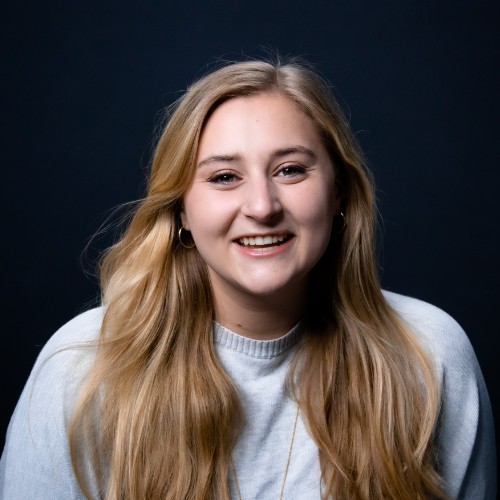
Sammi Reinstein
Today's Guests
